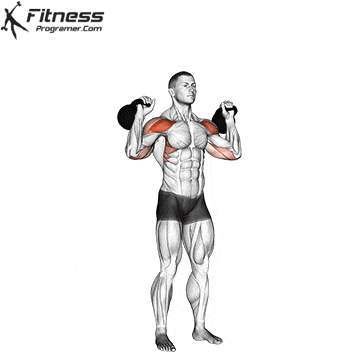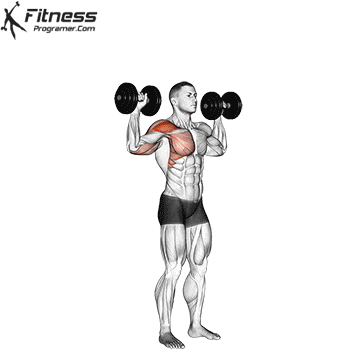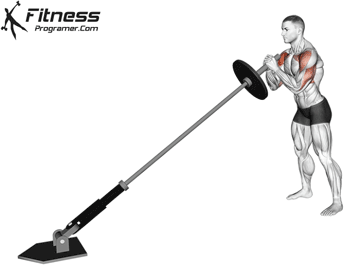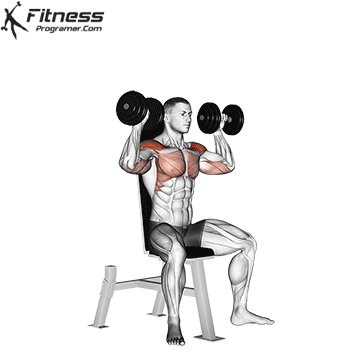Landmine Press Vs. Overhead Dumbbell Press For Shoulder Well being
Shoulder accidents are among the many commonest points encountered in each athletic and common health populations, usually ensuing from poor motion mechanics, overuse, or inadequate joint management. Two widespread overhead urgent variations—the landmine press and the overhead dumbbell press—are often really useful for growing shoulder power and stability. Nonetheless, the query stays: which of those two workout routines is safer and simpler for selling long-term shoulder well being?
This text explores the anatomical and biomechanical variations between these urgent variations and the way they affect elements comparable to joint loading, scapular motion, core stabilization, and threat of impingement.
Overhead Dumbbell Press: Basic Motion with Higher Mobility Calls for
The overhead dumbbell press is a standard free-weight motion during which two dumbbells are pressed vertically from shoulder peak to an overhead place, usually whereas standing or seated. This train is extremely efficient at concentrating on the deltoids, triceps, and higher trapezius, but it surely additionally locations important calls for on shoulder mobility and thoracic backbone extension.


Benefits:
- Promotes symmetrical improvement by working every arm independently
- Enhances shoulder proprioception and joint stability
- Permits for larger vary of movement, probably enhancing hypertrophy within the deltoids
Shoulder Well being Concerns:
Whereas efficient for muscular improvement, the overhead dumbbell press requires full shoulder flexion, scapular upward rotation, and thoracic extension to execute correctly. People with shoulder impingement, restricted overhead mobility, or anterior instability could wrestle to carry out this train safely. The vertical path of the dumbbell can even place the rotator cuff and subacromial area in danger when kind is compromised.
Landmine Press: Joint-Pleasant Various with Scapular Freedom
The landmine press entails urgent a barbell anchored at one finish in an arcing, upward-forward movement. Usually carried out from a half-kneeling or standing place, this motion has gained recognition for its joint-friendly trajectory, core activation, and flexibility for a variety of populations, together with these present process shoulder rehabilitation.

Benefits:
- Reduces compressive forces within the glenohumeral joint
- Encourages scapular upward rotation and protraction, enhancing shoulder kinematics
- Safer for people with restricted overhead mobility
- Requires robust core engagement because of the angled load and anti-rotational calls for
Shoulder Well being Concerns:
The landmine press’s diagonal urgent path considerably reduces the danger of mechanical impingement by avoiding full shoulder flexion. This train permits for extra pure scapulohumeral rhythm, which is very helpful in stopping overuse accidents within the rotator cuff and biceps tendon. Moreover, the landmine setup facilitates gradual load development and positional regression, making it excellent for each early-stage rehab and long-term efficiency coaching.
Biomechanical Variations
| Function | Overhead Dumbbell Press | Landmine Press |
|---|---|---|
| Arc of Movement | Vertical | Angled (upward and ahead at ~45 levels) |
| Scapular Freedom | Could also be restricted in poor thoracic posture | Naturally permits upward rotation and protraction |
| Thoracic Backbone Demand | Excessive (requires extension) | Reasonable |
| Rotator Cuff Stress | Reasonable to Excessive | Low to Reasonable |
| Core Involvement | Reasonable | Excessive (particularly anti-rotation in half-kneeling) |
| Finest For | Energy, hypertrophy with good mobility | Shoulder rehab, harm prevention, core management |
Which Is Safer for the Shoulder Joint?
The landmine press is broadly considered the safer possibility for people coping with present shoulder points or missing ample mobility to press overhead with correct mechanics. Its angled path of movement prevents the shoulder from shifting into probably impinged positions whereas nonetheless permitting for productive muscle engagement and overhead pressure improvement. Moreover, the decreased requirement for thoracic extension makes it accessible for people with posture-related limitations.
In distinction, the overhead dumbbell press is greatest fitted to people with wholesome, cell shoulders who can safely entry a full overhead place with out compensation. Though it stays a superb device for constructing urgent power and deltoid mass, it could enhance harm threat if carried out with poor kind or when mobility limitations exist.
Core Involvement and Useful Switch
An often-overlooked element of urgent actions is core activation. The landmine press, significantly within the half-kneeling stance, requires important engagement of the obliques, rectus abdominis, and gluteal muscle groups to stabilize the torso and stop rotation. This makes it a helpful device for enhancing purposeful shoulder stability by way of built-in motion patterns.
The overhead dumbbell press additionally recruits core musculature, particularly when carried out standing, however the symmetrical bilateral loading usually minimizes the anti-rotational demand seen within the landmine variation.
Conclusion
Each the landmine press and overhead dumbbell press supply helpful advantages for shoulder improvement, however they serve barely completely different roles in sustaining and enhancing shoulder well being. The landmine press offers a safer, extra accessible possibility for people with mobility limitations or harm historical past, making it a really perfect alternative for rehabilitation, prehabilitation, and foundational power.
In distinction, the overhead dumbbell press stays a extremely efficient hypertrophy device for the shoulders, but it surely requires correct kind and overhead mobility to keep away from impingement threat. Ideally, these actions can be utilized in tandem to strengthen secure urgent mechanics, stability mobility and power, and promote long-term shoulder integrity.
References
- Ludewig, P. M., & Cook dinner, T. M. (2000). Alterations in shoulder kinematics and related muscle exercise in individuals with signs of shoulder impingement. Bodily Remedy, 80(3), 276–291.
- Reinold, M. M., et al. (2004). Present ideas within the analysis and therapy of the shoulder in overhead-throwing athletes. Journal of Orthopaedic & Sports activities Bodily Remedy, 34(2), 61–79.
- Ebben, W. P., & Blackard, D. O. (2001). Energy and conditioning practices of Nationwide Soccer League power and conditioning coaches. Journal of Energy and Conditioning Analysis, 15(1), 48–58.
Source link
latest video
latest pick
news via inbox
Nulla turp dis cursus. Integer liberos euismod pretium faucibua






















